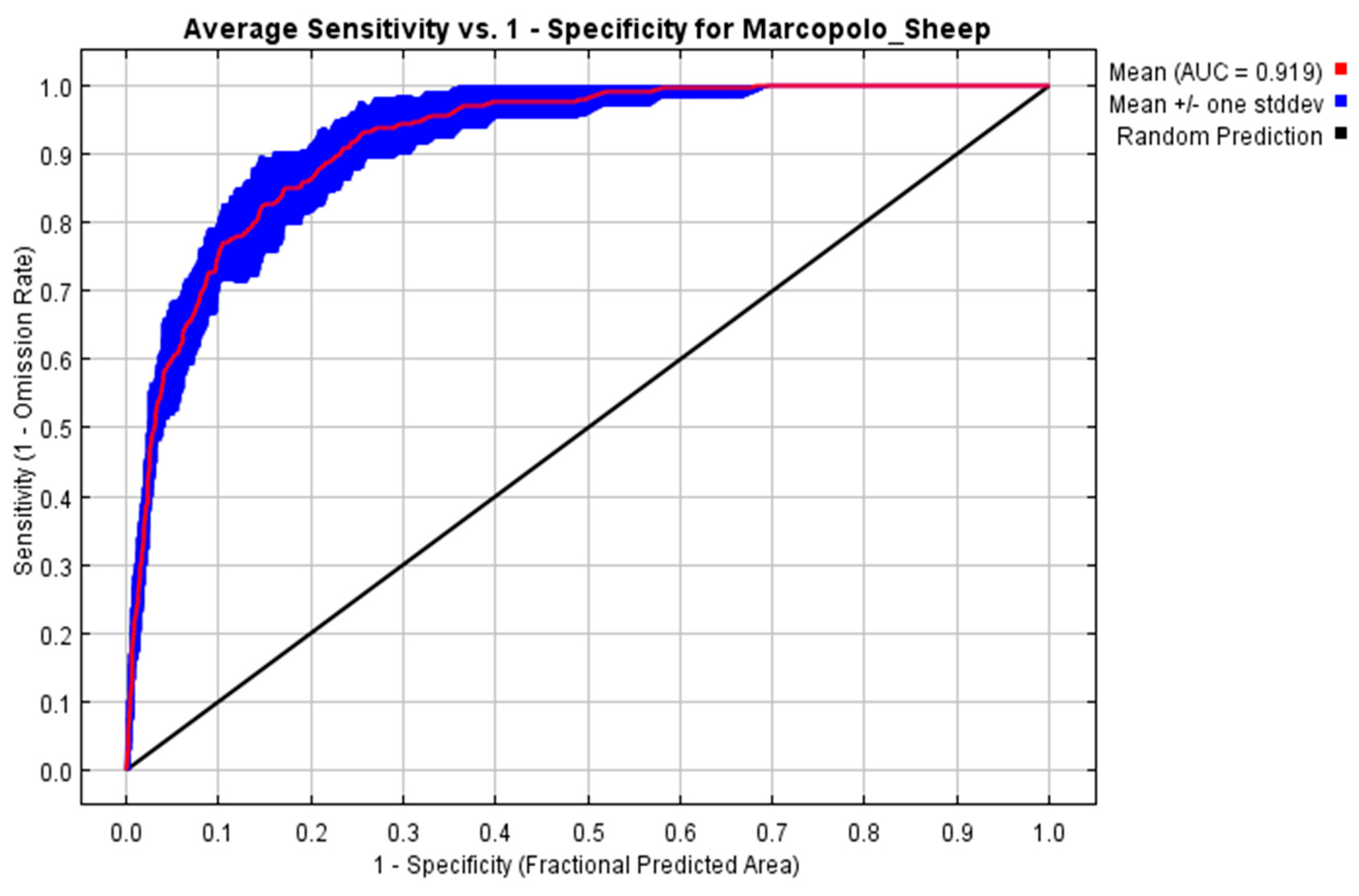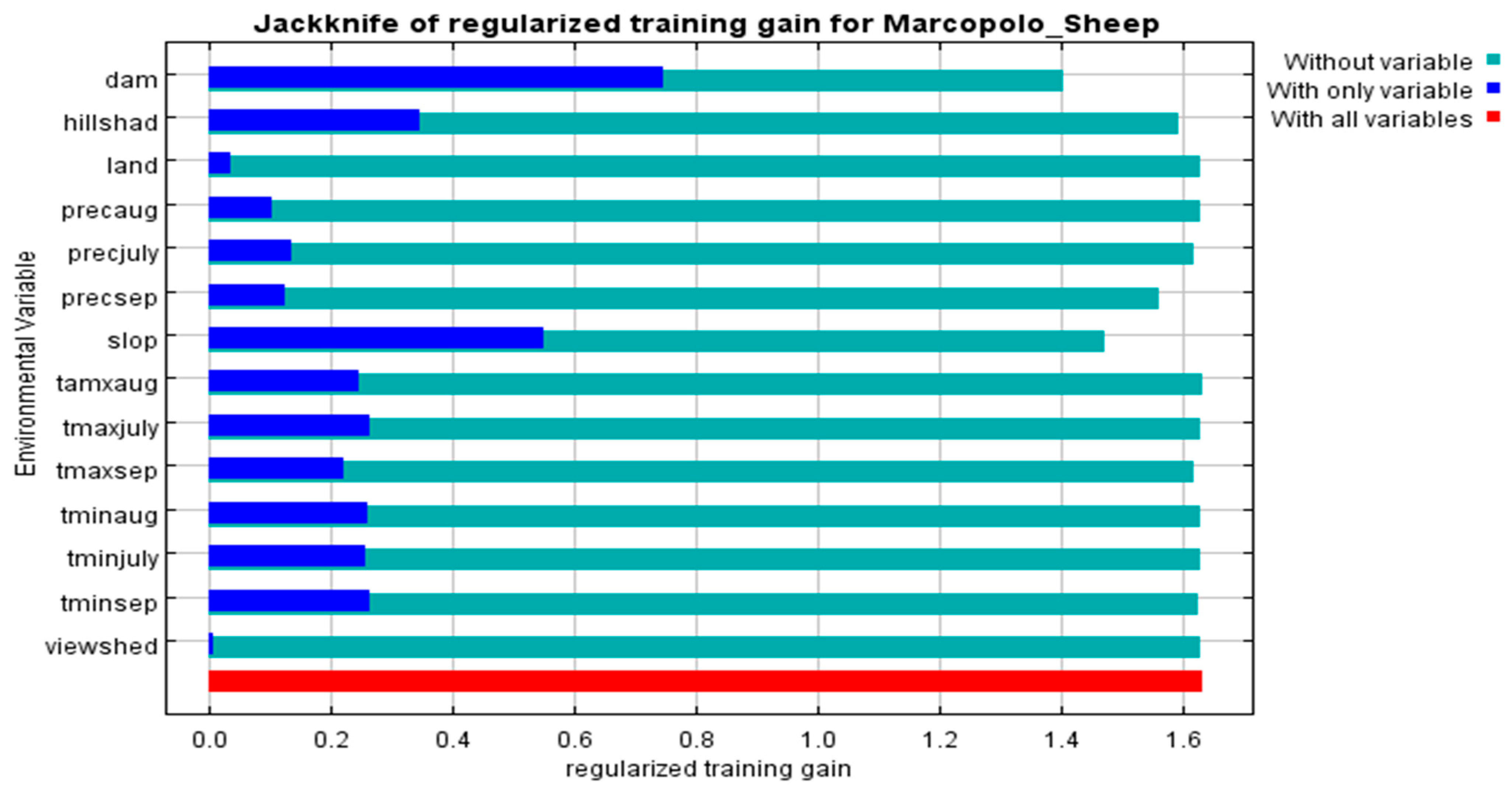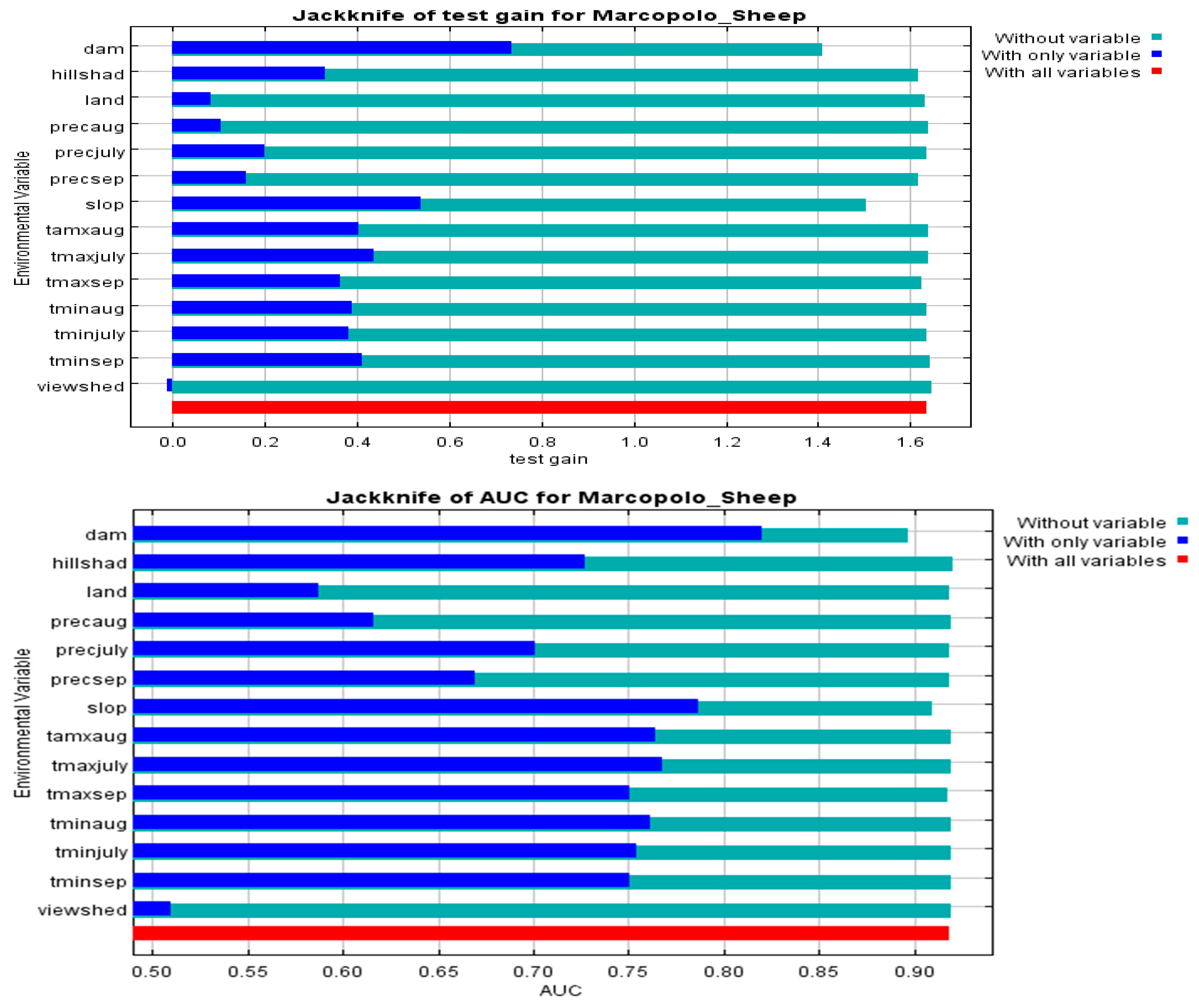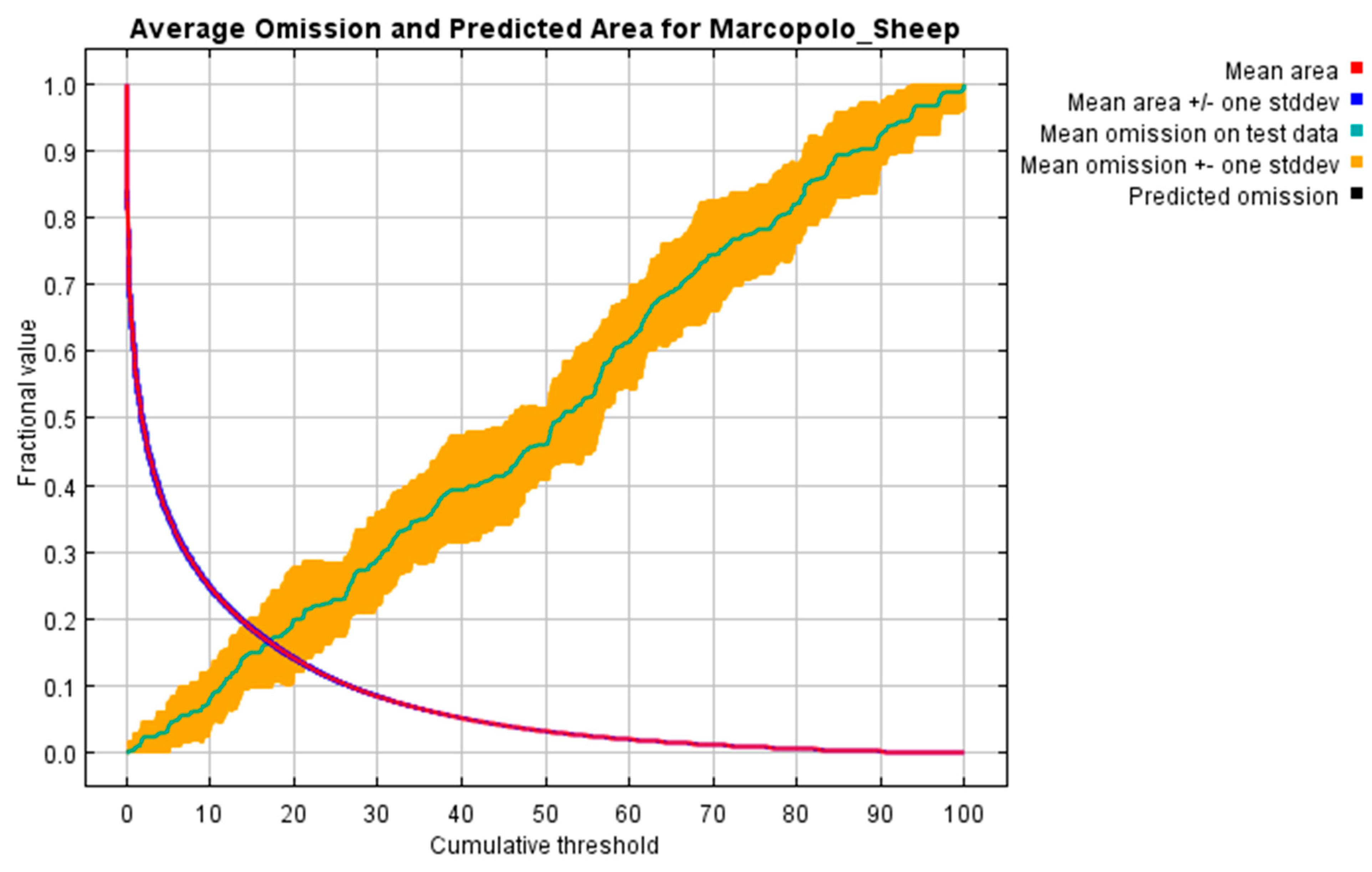Assessment of Habitat Suitability and Identification of Conservation Priority Areas for Endangered Marco Polo Sheep Throughout Khunjerab National Park (Pakistan) and Tashkurgan Natural Reserve (China)
Simple Summary
Abstract
1. Introduction
2. Materials and Methods
2.1. Study Area
2.2. Field Survey and Data Collection
3. Results
3.1. Average Sensitivity, Average Omission, and Jackknife Test
3.2. Modeling the Potential Geographic Distribution of Marco Polo Sheep
3.3. Key Environmental Parameters Influencing Marco Polo Sheep Distribution
3.4. Habitat Suitability Modeling and Threshold Optimization for Marco Polo Sheep Conservation
4. Discussion
4.1. Environmental and Anthropogenic Influences on Marco Polo Sheep Distribution
4.2. Regional Habitat Suitability and Distribution
4.3. Habitat Suitability Across the Study Area Varies Significantly
4.4. Habitat Suitability Thresholds and Conservation Implications
5. Conclusions
Supplementary Materials
Author Contributions
Funding
Institutional Review Board Statement
Informed Consent Statement
Data Availability Statement
Acknowledgments
Conflicts of Interest
References
- Schaller, G.B. A proposal for a Pamir international peace park. In Science and stewardship to protect and sustain wilderness values, Proceedings of the Eighth World Wilderness Congress Symposium, 30 September–6 October 2005 Anchorage, AK; Proceedings RMRS-P-49; Watson, A., Sproull, J., Dean, L., Eds.; U.S. Department of Agriculture, Forest Service, Rocky Mountain Research Station: Fort Collins, CO, USA, 2007; pp. 227–231. [Google Scholar]
- Schaller, G.B.; Kang, A. Status of Marco Polo sheep Ovis ammon polii in China and adjacent countries: Conservation of a vulnerable subspecies. Oryx 2008, 42, 100–106. [Google Scholar] [CrossRef]
- Schaller, G.B.; Li, H.; Talipu; Lu, H.; Ren, J.; Qiu, M.; Wang, H. Status of large mammals in the Taxkorgan Reserve, Xinjiang, China. Biol. Conserv. 1987, 42, 53–71. [Google Scholar] [CrossRef]
- Haider, J.; Khan, M.Z.; Anwer, M.; Ali, S.; Ali, H. Population status and migration trends of Marco Polo argali (Ovis ammon polii) in Pakistan. Mammalia 2018, 82, 481–485. [Google Scholar] [CrossRef]
- Valdez, R.; Michel, S.; Subbotin, A.; Klich, D. Status and population structure of a hunted population of Marco Polo Argali Ovis ammon polii (Cetartiodactyla, Bovidae) in Southeastern Tajikistan. Mammalia 2016, 80, 49–57. [Google Scholar] [CrossRef]
- Salas, E.A.L.; Valdez, R.; Michel, S. Summer and winter habitat suitability of Marco Polo argali in southeastern Tajikistan: A modeling approach. Heliyon 2017, 3, e00445. [Google Scholar] [CrossRef]
- Zhuo, Y.; Wang, M.; Liu, Z.; Xu, W.; Abdulnazar, A.; Rajabi, A.M.; Davletbakov, A.; Haider, J.; Khan, M.Z.; Loik, N.; et al. Border fences reduce potential for transboundary migration of Marco Polo Sheep (Ovis ammon polii) in the Pamir Plateau. Sci. Total Environ. 2024, 912, 169298. [Google Scholar] [CrossRef] [PubMed]
- Wang, M.; Blank, D.; Liu, W.; Wang, Y.; Yang, W. The group pattern of Marco Polo sheep in the Chinese Pamir plateau. Eur. J. Wildl. Res. 2018, 64, 75. [Google Scholar] [CrossRef]
- Zhang, Y.; Song, W. Identify ecological corridors and build potential ecological networks in response to recent land cover changes in Xinjiang, China. Sustainability 2020, 12, 8960. [Google Scholar] [CrossRef]
- Khan; Zafar, M.; Babar, K.; Ejaz Ahmed, E.A.; Garee Khan, G.K.; Anila Ajmal, A.A.; Rehmat Ali, R.A.; Saeed Abbas, S.A.; Muhammad Ali, M.A.; Ejaz Hussain, E.H.; et al. Abundance, Distribution and Conservation of Key Ungulate Species in Hindu Kush, Karakoram and Western Himalayan (HKH) Mountain Ranges of Pakistan. Int. J. Agric. Biol. 2014, 16, 1050–1058. [Google Scholar]
- Khan, G.; Khan, B.; Qamer, F.M.; Abbas, S.; Khan, A.; Xi, C. Himalayan ibex (Capra ibex sibirica) habitat suitability and range resource dynamics in the Central Karakorum National Park, Pakistan. J. King Saud. Univ.-Sci. 2016, 28, 245–254. [Google Scholar] [CrossRef]
- Schaller, G.B.; Li, H.; Talipu; Ren, J.; Qiu, M. The snow leopard in Xinjiang, China. Oryx 1988, 22, 197–204. [Google Scholar] [CrossRef]
- IUCN. The IUCN Red List of Threatened Species; International Union for Conservation of Nature and Natural Resources: Gland, Switzerland, 2020. [Google Scholar]
- Khan, B.; Ablimit, A.; Khan, G.; Jasra, A.W.; Ali, H.; Ali, R.; Ahmad, E.; Ismail, M. Abundance, distribution and conservation status of Siberian ibex, Marco Polo and Blue sheep in Karakoram-Pamir mountain area. J. King Saud. Univ.-Sci. 2016, 28, 216–225. [Google Scholar] [CrossRef]
- Khan, B.; Abdukadir, A.; Qureshi, R.; Mustafa, G. Medicinal uses of plants by the inhabitants of Khunjerab National Park, Gilgit, Pakistan. Pak. J. Bot. 2011, 43, 2301–2310. [Google Scholar]
- Ali, H.; Younus, M.; Din, J.U.; Bischof, R.; Nawaz, M.A. Do Marco Polo argali Ovis ammon polii persist in Pakistan? Oryx 2019, 53, 329–333. [Google Scholar] [CrossRef]
- Rasool, G. Population status of wildlife in Khunjerab National Park (Pakistan). Tigerpaper 1990, 17. [Google Scholar]
- Fatima, S.H.; Atif, S.; Rasheed, S.B.; Zaidi, F.; Hussain, E. Species Distribution Modelling of Aedes aegypti in two dengue-endemic regions of Pakistan. Trop. Med. Int. Health 2016, 21, 427–436. [Google Scholar] [CrossRef] [PubMed]
- Brown, J.L.; Bennett, J.R.; French, C.M. SDM tool box 2.0: The next generation Python-based GIS toolkit for landscape genetic, biogeographic and species distribution model analyses. PeerJ 2017, 5, e4095. [Google Scholar] [CrossRef]
- Evcin, O.; Kucuk, O.; Akturk, E. Habitat suitability model with maximum entropy approach for European roe deer (Capreolus capreolus) in the Black Sea Region. Environ. Monit. Assess. 2019, 191, 669. [Google Scholar] [CrossRef]
- Oruç, M.S.; Mert, A.; Özdemir, İ. Modelling habitat suitability for red deer (Cervus elaphus L.) using environmental variables in çatacık region. Bilge Int. J. Sci. Technol. Res. 2017, 1, 135–142. [Google Scholar]
- Nneji, L.M.; Salako, G.; Oladipo, S.O.; Ayoola, A.O.; Onadeko, A.B.; Adedeji, B.E.; Omotoso, O.; Ugwumba, A.A.A.; Adeola, A.C. Species Distribution Modelling predicts habitat suitability and reduction of suitable habitat under future climatic scenario for Sclerophrys perreti: A critically endangered Nigerian endemic toad. Afr. J. Ecol. 2020, 58, 481–491. [Google Scholar] [CrossRef]
- Yi, Y.-J.; Cheng, X.; Yang, Z.-F.; Zhang, S.-H. Maxent modeling for predicting the potential distribution of endangered medicinal plant (H. riparia Lour) in Yunnan, China. Ecol. Eng. 2016, 92, 260–269. [Google Scholar] [CrossRef]
- Kumar, S.; Stohlgren, T.J. Maxent modeling for predicting suitable habitat for threatened and endangered tree Canacomyrica monticola in New Caledonia. J. Ecol. Nat. Environ. 2009, 1, 94–98. [Google Scholar]
- Haghani, A.; Aliabadian, M.; Sarhangzadeh, J.; Setoodeh, A. Seasonal habitat suitability modeling and factors affecting the distribution of Asian Houbara in East Iran. Heliyon 2016, 2, e00142. [Google Scholar] [CrossRef] [PubMed]
- Halvorsen, R.; Mazzoni, S.; Dirksen, J.W.; Næsset, E.; Gobakken, T.; Ohlson, M. How important are choice of model selection method and spatial autocorrelation of presence data for distribution modelling by MaxEnt? Ecol. Model. 2016, 328, 108–118. [Google Scholar] [CrossRef]
- Merow, C.; Smith, M.J.; Silander, J.A., Jr. A practical guide to MaxEnt for modeling species’ distributions: What it does, and why inputs and settings matter. Ecography 2013, 36, 1058–1069. [Google Scholar] [CrossRef]
- Salas, E.A.L.; Valdez, R.; Michel, S.; Boykin, K.G. Habitat assessment of Marco Polo sheep (Ovis ammon polii) in Eastern Tajikistan: Modeling the effects of climate change. Ecol. Evol. 2018, 8, 5124–5138. [Google Scholar] [CrossRef]
- Su, H.; Bista, M.; Li, M. Mapping habitat suitability for Asiatic black bear and red panda in Makalu Barun National Park of Nepal from Maxent and GARP models. Sci. Rep. 2021, 11, 14135. [Google Scholar] [CrossRef]
- Hameed, S.; Ahmad, S.; Din, J.; Ali, H.; Younas, M.; Kabir, M.; Lorestani, N.; Jahan, S.; Nawaz, M.A. Mapping Habitat Suitability and Connectivity for Himalayan Brown Bears in Pakistan: Implications for Conservation Management. Glob. Ecol. Conserv. 2025, 59, e03570. [Google Scholar] [CrossRef]
- Qureshi, R.; Khan, W.A.; Bhatti, G.; Khan, B. First report on the biodiversity of Khunjerab National Park, Pakistan. Pak. J. Bot. 2011, 43, 849–861. [Google Scholar]
- Shafiq, M.M.; Ali, A. Status of large mammal species in Khunjerab National Park. Pak. J. For. 1998, 48, 91–96. [Google Scholar]
- Shedayi, A.A.; Xu, M.; Hussain, F.; Sadia, S. Threatened plant resources: Distribution and ecosystem services in the world’s high elevation park of the karakoram ranges. Pak. J. Bot. 2016, 48, 999–1012. [Google Scholar]
- Phillips, S.J.; Anderson, R.P.; Schapire, R.E. Maximum entropy modeling of species geographic distributions. Ecol. Model. 2006, 190, 231–259. [Google Scholar] [CrossRef]
- Houston, C.S.; McLoughlin, P.D.; Mandel, J.T.; Bechard, M.J.; Stoffel, M.J.; Barber, D.R.; Bildstein, K.L. Breeding home ranges of migratory Turkey Vultures near their northern limit. Wilson J. Ornithol. 2011, 123, 472–478. [Google Scholar] [CrossRef]
- Aikens, E.O.; Dwinnell, S.P.; LaSharr, T.N.; Jakopak, R.P.; Fralick, G.L.; Randall, J.; Kaiser, R.; Thonhoff, M.; Kauffman, M.J.; Monteith, K.L. Migration distance and maternal resource allocation determine timing of birth in a large herbivore. Ecology 2021, 102, e03334. [Google Scholar] [CrossRef]
- Roberts, T.J.; Bernhard. The Mammals of Pakistan; ERNEST BENN LIMITED: London, UK, 1977. [Google Scholar]
- Sabooryar, J.; Arifi, A.; Majidi, A.H.; Neyazi, G.R. Current Status of Marco Polo Sheep (Ovis ammon polii) in the Pamir Mountains of Badakhshan Province, Afghanistan. Int. J. Biol. Phys. Chem. Stud. 2024, 6, 10–16. [Google Scholar] [CrossRef]
- Schaller, G.B. Mountain Monarchs: Wild Sheep and Goats of the Himalaya; University of Chicago Press: Chicago, IL, USA, 1977. [Google Scholar]
- Thompson, C.J. Elk Habitat Selection in Response to Predation Risk from Mexican Gray Wolves; New Mexico State University: Las Cruces, NM, USA, 2022. [Google Scholar]
- Shrestha, B. Status, distribution and potential habitat of Himalayan tahr (Hemitragus jemlahicus) and conflict areas with livestock in Sagarmatha National Park, Nepal. Nepal J. Sci. Technol. 2006, 7, 27–34. [Google Scholar] [CrossRef]
- Adnan, M.; Xiao, B.; Bibi, S.; Xiao, P.; Zhao, P.; Wang, H.; Ali, M.U.; An, X. Known and unknown environmental impacts related to climate changes in Pakistan: An under-recognized risk to Local communities. Sustainability 2024, 16, 6108. [Google Scholar] [CrossRef]
- Gugger, S.; Kesselring, H.; Stöcklin, J.; Hamann, E. Lower plasticity exhibited by high-versus mid-elevation species in their phenological responses to manipulated temperature and drought. Ann. Bot. 2015, 116, 953–962. [Google Scholar] [CrossRef]
- Aycrigg, J.L.; Wells, A.G.; Garton, E.O.; Magipane, B.; Liston, G.E.; Prugh, L.R.; Rachlow, J.L.; Halliday, W.D. Habitat selection by Dall’s sheep is influenced by multiple factors including direct and indirect climate effects. PLoS ONE 2021, 16, e0248763. [Google Scholar] [CrossRef]
- Beus, T. Habitat Modeling Using Path Analysis: Delineating Mountain Goat Habitat in the Washington Cascades; Western Washington University: Bellingham, WA, USA, 2010. [Google Scholar]
- Ferrari, E. Methodological Issues in Implementing a Sustainable Forest Management Plan in Remote Mountain Areas—The Karakorum (Pakistan); CINECA: Bologna, Italy, 2014. [Google Scholar]
- Wang, Y.; Dai, Z.; Yang, S.; Luo, Y. The distribution of Marco Polo sheep and their habitat vegetation dynamics in east Pamir. Acta Ecol. Sin. 2016, 36, 209–217. [Google Scholar]
- Han, X.; Webber, M. From Chinese dam building in Africa to the Belt and Road Initiative: Assembling infrastructure projects and their linkages. Political Geogr. 2020, 77, 102102. [Google Scholar] [CrossRef]






| S/NO | Description of the Variables | Unit | Resolution | Source |
|---|---|---|---|---|
| 1 | Elevation/DEM | M | 30 m | USGS Earth data portal |
| 2 | Hillshed | M | 30 m | By calculation |
| 3 | Land cover | Km2 | 10 m | ESRI |
| 4 | Precipitation (Aug) | Mm | 2.5 min | WorldClim |
| 5 | Precipitation (July) | Mm | 2.5 min | WorldClim |
| 6 | Precipitation (Sep) | Mm | 2.5 min | WorldClim |
| 7 | Slop | “°” | 30 m | By calculation |
| 8 | Maximum temperature (Aug) | °C | 2.5 min | WorldClim |
| 9 | Maximum temperature (July) | °C | 2.5 min | WorldClim |
| 10 | Minimum temperature (Sep) | °C | 2.5 min | WorldClim |
| 11 | Minimum temperature (Aug) | °C | 2.5 min | WorldClim |
| 12 | Minimum temperature (July) | °C | 2.5 min | WorldClim |
| 13 | Maximum temperature (Sep) | °C | 2.5 min | WorldClim |
| 14 | Viewshed | M | 30 m | By calculation |
| Variable | Percent Contribution | Permutation Importance |
|---|---|---|
| elevation | 43.9 | 19.3 |
| slop | 25.9 | 11.8 |
| precsep | 15.9 | 16.9 |
| hillshed | 4.7 | 2 |
| tamxaug | 3.2 | 6.5 |
| tminsep | 1.9 | 3.6 |
| tminjuly | 1.4 | 0.6 |
| tmaxsep | 0.9 | 16.5 |
| tminaug | 0.8 | 0.6 |
| tmaxjuly | 0.7 | 15.9 |
| precjuly | 0.3 | 5.7 |
| land cover | 0.2 | 0.1 |
| viewshed | 0.1 | 0.1 |
| precaug | 0 | 0.4 |
| Cumulative Threshold | Cloglog Threshold | Description | Fractional Predicted Area | Training Omission Rate | Test Omission Rate | p-Value |
|---|---|---|---|---|---|---|
| 1.000 | 0.015 | Fixed cumulative value 1 | 0.599 | 0.000 | 0.000 | 2.105 × 10−5 |
| 5.000 | 0.060 | Fixed cumulative value 5 | 0.360 | 0.016 | 0.000 | 4.768 × 10−10 |
| 10.000 | 0.117 | Fixed cumulative value 10 | 0.250 | 0.054 | 0.095 | 4.467 × 10−10 |
| 1.921 | 0.025 | Minimum training presence | 0.506 | 0.000 | 0.000 | 6.136 × 10−7 |
| 17.528 | 0.199 | 10-percentile training presence | 0.163 | 0.097 | 0.095 | 1.629 × 10−13 |
| 21.013 | 0.239 | Equal training sensitivity and specificity | 0.135 | 0.135 | 0.143 | 1.983 × 10−13 |
| 17.233 | 0.194 | Maximum training sensitivity plus specificity | 0.166 | 0.081 | 0.095 | 2.199 × 10−13 |
| 19.975 | 0.225 | Equal test sensitivity and specificity | 0.143 | 0.135 | 0.143 | 5.281 × 10−13 |
| 19.899 | 0.224 | Maximum test sensitivity plus specificity | 0.143 | 0.130 | 0.095 | 1.467 × 10−14 |
| 2.939 | 0.037 | Balance training omission, predicted area, and threshold value | 0.442 | 0.005 | 0.000 | 3.617 × 10−8 |
| 14.161 | 0.163 | Equate entropy of thresholded and original distributions | 0.196 | 0.081 | 0.095 | 5.191 × 10−12 |
Disclaimer/Publisher’s Note: The statements, opinions and data contained in all publications are solely those of the individual author(s) and contributor(s) and not of MDPI and/or the editor(s). MDPI and/or the editor(s) disclaim responsibility for any injury to people or property resulting from any ideas, methods, instructions or products referred to in the content. |
© 2025 by the authors. Licensee MDPI, Basel, Switzerland. This article is an open access article distributed under the terms and conditions of the Creative Commons Attribution (CC BY) license (https://creativecommons.org/licenses/by/4.0/).
Share and Cite
Karim, I.; Liu, X.; Khan, B.; Kazmi, T. Assessment of Habitat Suitability and Identification of Conservation Priority Areas for Endangered Marco Polo Sheep Throughout Khunjerab National Park (Pakistan) and Tashkurgan Natural Reserve (China). Animals 2025, 15, 1907. https://doi.org/10.3390/ani15131907
Karim I, Liu X, Khan B, Kazmi T. Assessment of Habitat Suitability and Identification of Conservation Priority Areas for Endangered Marco Polo Sheep Throughout Khunjerab National Park (Pakistan) and Tashkurgan Natural Reserve (China). Animals. 2025; 15(13):1907. https://doi.org/10.3390/ani15131907
Chicago/Turabian StyleKarim, Ishfaq, Xiaodong Liu, Babar Khan, and Tahir Kazmi. 2025. "Assessment of Habitat Suitability and Identification of Conservation Priority Areas for Endangered Marco Polo Sheep Throughout Khunjerab National Park (Pakistan) and Tashkurgan Natural Reserve (China)" Animals 15, no. 13: 1907. https://doi.org/10.3390/ani15131907
APA StyleKarim, I., Liu, X., Khan, B., & Kazmi, T. (2025). Assessment of Habitat Suitability and Identification of Conservation Priority Areas for Endangered Marco Polo Sheep Throughout Khunjerab National Park (Pakistan) and Tashkurgan Natural Reserve (China). Animals, 15(13), 1907. https://doi.org/10.3390/ani15131907









